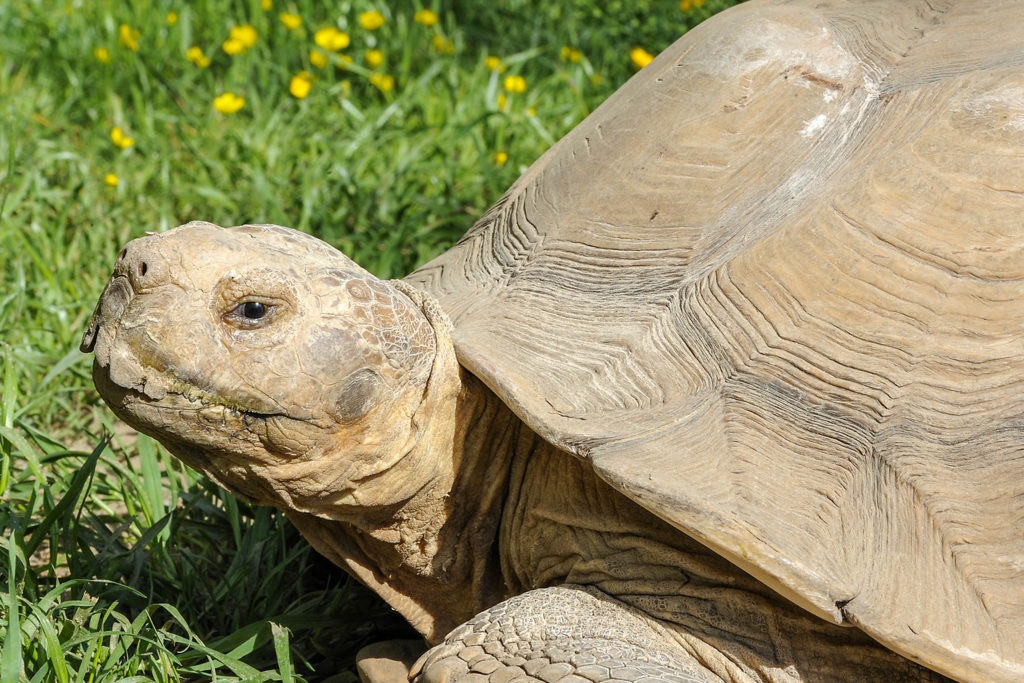Overview
“Where I live”
The Sulcata tortoise is native to the Sahara Desert and the Sahel, a transitional eco-region of semi-arid grasslands, scrub, and savannah in northern Africa. See them at the Maryland Zoo in the African Journey.
“How I live there”
Sulcata tortoises are big, slow, and tough survivalists. Adults average 18 inches in shell length and 70 to 100 pounds in weight, but specimens reaching two to three feet in length and upwards of 150 pounds aren’t uncommon.
Sulcatas dig burrows in the ground where they take shelter from their harsh, hot, arid habitat. Most burrows average 30 inches in depth, but some tortoises will dig tunnel systems extending 10 or more feet underground. The burrows are relatively cool and damp, which – along with natural water conservation adaptations such as strict regulation of urine output – keeps these tortoises from drying out.
It’s clear that Sulcatas have adapted to extreme heat, but how well they tolerate cold temperatures is less well known. Like most arid tortoises, however, they seem better adapted to temperature fluctuations than many other species of turtle and tortoise. What’s fascinating about them is that when it gets cold outside, they actively seek refuge. Many tropical tortoises would not take active steps to maintain a steady body temperature, and would just freeze when confronted by cold.
The Maryland Zoo has one male and two female Sulcata tortoises that you can see in African Journey. In cool weather (temperatures as low as the 50s), they will continue to move about outside and graze, so long as they can retreat to their heated burrow whenever they need to warm up.
By moving slowly, Sulcatas conserve energy, which enables them to go weeks without food. In the wild, they mainly eat grasses and leaves of desert scrub. During the cooler parts of the day, they walk slowly and graze. They get the water that they need from the plants that they eat. Water is scarce in their habitat, and it’s not known what wild spur thighs do on the rare occasions that they encounter water. At the Zoo, the Sulcata tortoises do not appear to drink water, and show very little interest in water. This confirms that they are getting all the water that they need from their diet.
“Making my mark”
Sulcata tortoises are large and very strong. They can push and knock over heavy objects with ease. They may ram each other, and males especially tend to ram females. The force with which one tortoise rams another can be intimidating, given their strength, but it is a natural behavior.
“What eats me”
Sulcata tortoises have few natural predators. They are able to withdraw completely into their shells, leaving only the front surfaces of their scaled forelegs and the soles of their back feet showing. They are more at the mercy of their harsh habitat and humans than other animal predators.
Raising Young
Tortoises and other reptiles don’t exactly “raise young.” They mate, the females lay eggs, and parental involvement stops there. Here’s how it happens with Sulcata tortoises.
Mating occurs between September and late November, just after the rainy season. Males fight each other for breeding rights with females. About 60 days after mating, females start wandering in search of the perfect nesting sites. Each female may spend up to two weeks finding a site that suits her before excavating a nest. She’ll spend about 5 hours kicking away loose dirt, creating a depression in the ground, frequently urinating in it. She’ll end up with a nest about 2 feet wide and 3 to 6 inches deep. She’ll then lay her eggs, one every three minutes, until she has a clutch of 15 to 30 on average. She then spends about an hour filling in her nest, covering all the eggs.
The baby tortoises hatch after about 8 months. They are only 2 to 3 inches long at birth, but grow quickly.
Conservation
Sulcata tortoises are listed currently as vulnerable by the IUCN, the world’s leading conservation organization. They are threatened by habitat loss and over-collection for the pet trade.
Taxonomy
- Kingdom: Animalia
- Phylum: Chordata
- Subphylum: Vertebrata
- Class: Reptila
- Order: Testudines
- Family: Testudinidae
- Genera: Centrochelys
- Species: sulcata

